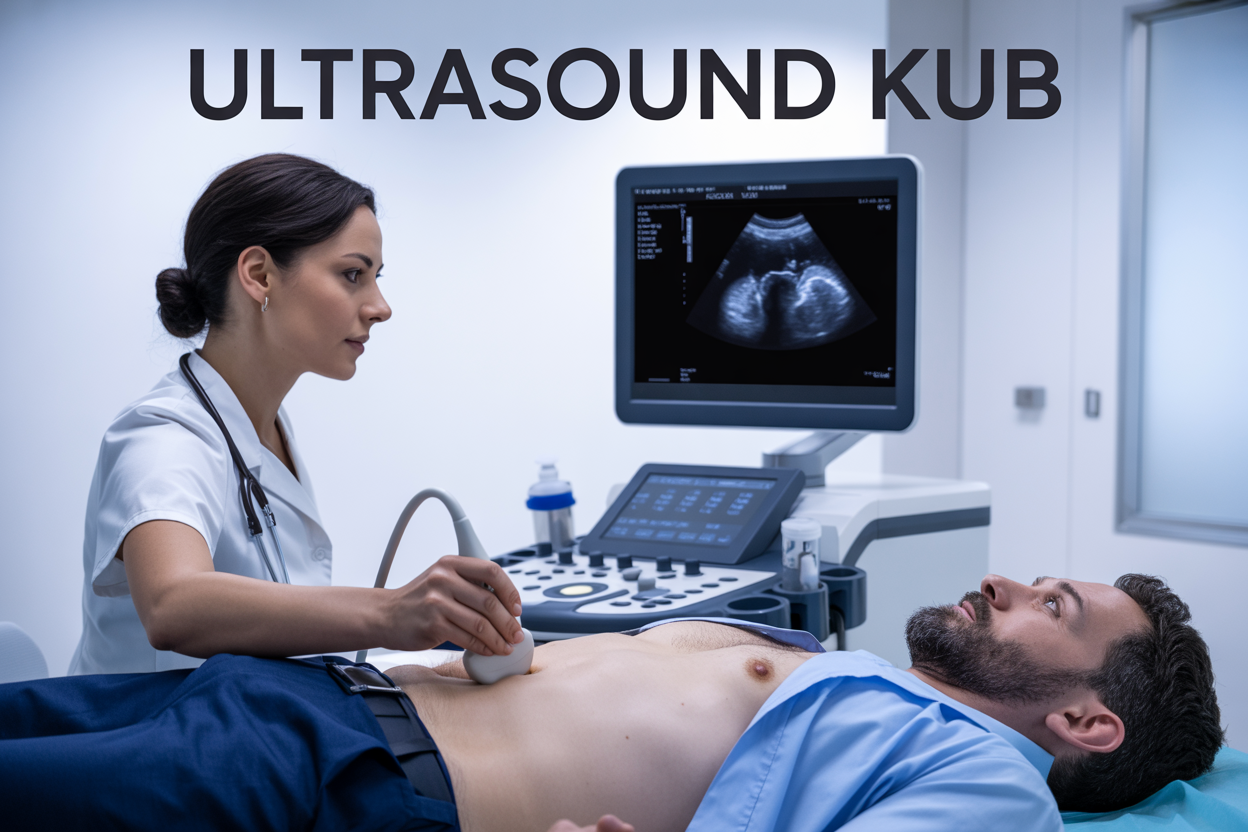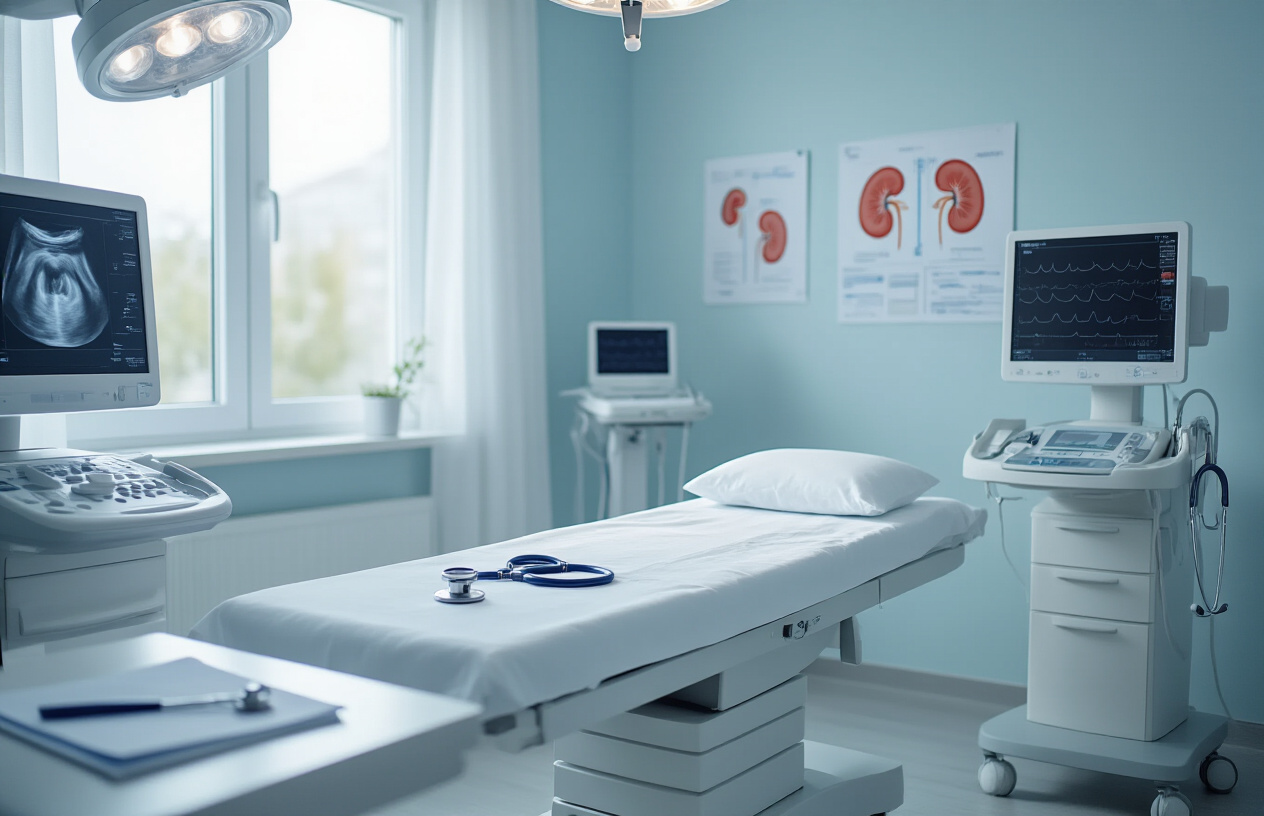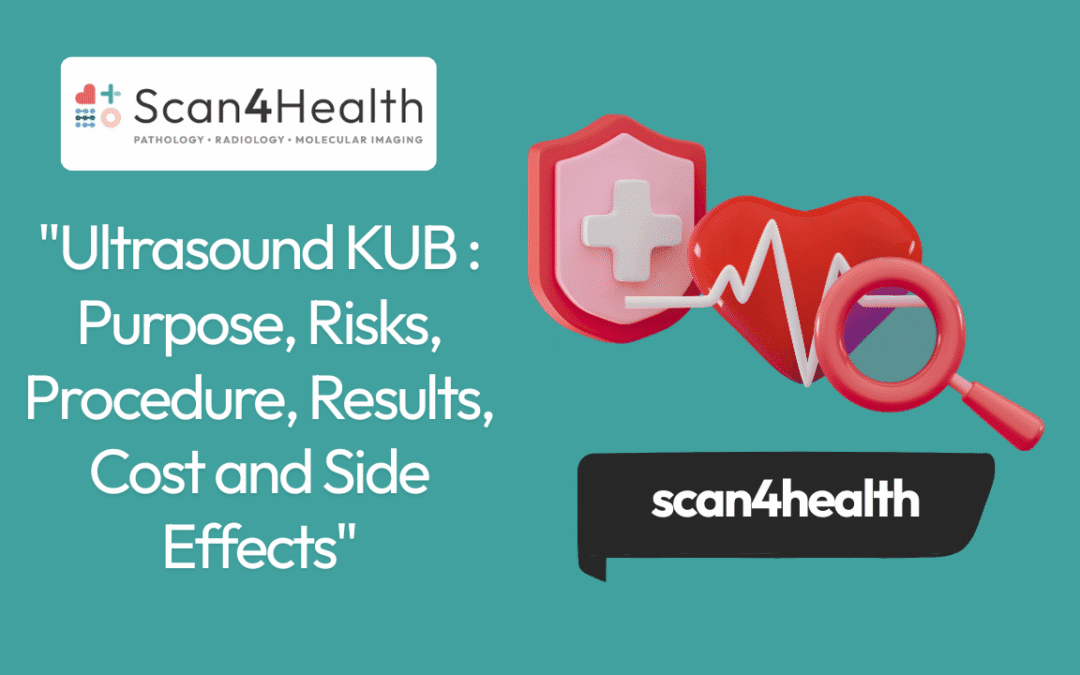“A Complete Guide to Ultrasound KUB – Why It’s Done, How It Works & What to Expect”

Ultrasound KUB: Your Complete Guide to This Essential Kidney and Bladder Scan
An ultrasound KUB is a safe, non-invasive imaging test that examines your kidneys, ureters, and bladder using sound waves. This kidney bladder ultrasound helps doctors diagnose various urinary tract conditions, from kidney stones to infections, without radiation exposure.
This guide is perfect for patients scheduled for a KUB ultrasound procedure, their families, or anyone curious about this common diagnostic test. You’ll learn what to expect, how much it costs, and what your results mean.
We’ll walk you through the complete ultrasound KUB procedure step-by-step, so you know exactly what happens during your appointment. You’ll also discover how to read your ultrasound KUB results and understand what different findings mean for your health. Finally, we’ll break down KUB scan cost factors and explain how insurance typically covers this renal ultrasound procedure.
Whether you’re experiencing kidney pain, urinary symptoms, or need routine monitoring, understanding your ultrasound kidneys ureters bladder exam will help you feel more confident and prepared.
Understanding Ultrasound KUB and Its Medical Purpose
What is Ultrasound KUB and How It Works
An ultrasound KUB is a non-invasive imaging technique that examines your kidneys, ureters, and bladder using high-frequency sound waves. The acronym “KUB” stands for Kidneys, Ureters, and Bladder – the three main components of your urinary system that doctors need to evaluate when you’re experiencing urological symptoms.
During a KUB ultrasound procedure, a trained sonographer applies a special gel to your abdomen and back, then moves a small device called a transducer across your skin. This transducer sends sound waves into your body, which bounce back when they hit different organs and tissues. The machine converts these returning sound waves into real-time images that appear on a monitor.
The kidney bladder ultrasound works by detecting changes in tissue density and fluid levels. Solid masses like kidney stones appear bright white on the screen, while fluid-filled areas like a full bladder show up as dark spaces. This contrast helps medical professionals identify abnormalities in your urinary tract.
What makes the ultrasound kidneys ureters bladder examination particularly valuable is its ability to show both structure and function. Doctors can observe blood flow through your kidneys, measure the size of organs, and detect blockages in real-time without exposing you to radiation or requiring contrast dyes.
The renal ultrasound procedure typically takes 30-45 minutes and provides immediate results, making it an excellent first-line diagnostic tool for urinary tract problems.
Key Medical Conditions Diagnosed Through KUB Ultrasound
The abdominal ultrasound KUB serves as a diagnostic powerhouse for detecting numerous urological conditions. Kidney stones rank among the most common findings, appearing as bright, echogenic spots that cast shadows on the ultrasound image. When stones block urine flow, the scan reveals swollen kidneys and dilated collecting systems.
Bladder conditions become clearly visible during the examination. Doctors can identify bladder tumors, measure bladder wall thickness, and assess how completely your bladder empties after urination. Urinary retention shows up as excessive fluid remaining in the bladder post-void.
Kidney abnormalities appear prominently on ultrasound KUB results. Simple cysts look like dark, fluid-filled circles with thin walls, while complex cysts may show internal debris or thick walls requiring further investigation. Polycystic kidney disease creates a characteristic “Swiss cheese” appearance with multiple cysts throughout both kidneys.
Infections and inflammatory conditions alter normal tissue patterns. Pyelonephritis causes kidney swelling and changes in echo patterns, while chronic kidney disease shows smaller, more echogenic kidneys with poor definition between the cortex and medulla.
Structural abnormalities become apparent during the scan. Congenital conditions like horseshoe kidney or duplicated collecting systems are easily identified. Hydronephrosis – kidney swelling due to urine backup – appears as dilated fluid-filled spaces within the kidney.
Tumors and masses require careful evaluation through ultrasound imaging. While the scan cannot definitively diagnose cancer, it identifies suspicious solid masses that need additional testing like CT scans or biopsies for proper diagnosis.
Potential Risks and Safety Considerations
Common Side Effects During and After the Procedure
The ultrasound KUB procedure is remarkably safe and typically produces no side effects for most patients. Unlike X-rays or CT scans, this imaging technique doesn’t use ionizing radiation, making it one of the safest diagnostic tools available. During the examination, you might experience mild pressure from the transducer as the technologist moves it across your abdomen, but this sensation is temporary and painless.
Some patients report minor discomfort from having a full bladder, which is often required for optimal kidney bladder ultrasound imaging. This temporary discomfort resolves immediately after you empty your bladder following the procedure. The gel used during the ultrasound KUB procedure is water-based and hypoallergenic, so allergic reactions are extremely rare.
Very occasionally, patients with sensitive skin might notice slight redness where the gel was applied, but this fades within minutes. If you have claustrophobia or anxiety about medical procedures, you might feel nervous, but the open nature of ultrasound equipment and the brief duration of the exam help minimize these concerns.
The renal ultrasound procedure itself causes no lasting effects on your body. You can return to normal activities immediately afterward, including eating, drinking, and taking medications as usual. There’s no recovery time needed, and you won’t experience any kidney ultrasound side effects that interfere with your daily routine.
Special Precautions for Pregnant Women
Pregnancy doesn’t prevent you from having an ultrasound KUB when medically necessary. Ultrasound technology has been used safely during pregnancy for decades without any documented harmful effects to developing babies. The sound waves used in the ultrasound kidneys ureters bladder examination are the same frequency used for routine prenatal monitoring.
Your doctor will carefully weigh the benefits against any theoretical risks before ordering this test during pregnancy. If you’re experiencing kidney stones, urinary tract infections, or other kidney-related symptoms while pregnant, the information gained from the KUB ultrasound procedure often outweighs any minimal concerns.
Special positioning might be needed during later stages of pregnancy to ensure your comfort and get clear images. The technologist will work with you to find positions that don’t put pressure on your abdomen or cause discomfort. You might need to lie on your side rather than flat on your back.
Inform your healthcare provider immediately if you’re pregnant or might be pregnant before scheduling your abdominal ultrasound KUB. While ultrasound is considered safe during pregnancy, your doctor might adjust the examination technique or timing based on your specific trimester and medical needs. The procedure duration might be shortened, and extra care will be taken to minimize any unnecessary exposure time while still obtaining the diagnostic information needed.
Step-by-Step Ultrasound KUB Procedure Guide
Pre-Procedure Preparation Requirements
Before your ultrasound KUB procedure, your doctor will provide specific preparation instructions to ensure the clearest possible images of your kidneys, ureters, and bladder. The most important requirement involves drinking water to fill your bladder. You’ll typically need to consume 32-40 ounces of clear fluids about one hour before your appointment and avoid urinating until after the scan is complete. A full bladder acts as an acoustic window, pushing intestinal gas away from the imaging area and providing better visualization of your pelvic organs.
Your healthcare team will also ask you to fast for 8-12 hours before the renal ultrasound procedure if your doctor needs clear images of your kidneys. This fasting period helps reduce intestinal gas that can interfere with sound wave transmission. Remove all jewelry, particularly around your abdomen and lower back, as metal objects can create artifacts on the images.
Wear comfortable, loose-fitting clothing that allows easy access to your abdomen and back. Many facilities provide hospital gowns, but you can often keep your clothes on if they don’t have metal fasteners or tight waistbands. Bring your insurance information, photo ID, and any previous imaging studies your doctor has requested. Some patients find it helpful to arrive 15-30 minutes early to complete any necessary paperwork without feeling rushed.
What Happens During the Imaging Session
The ultrasound KUB typically takes 30-45 minutes and occurs in a dimly lit examination room to help the sonographer see the monitor clearly. You’ll lie on your back on an examination table, and the technologist will apply warm, water-based gel to your abdomen and lower back. This gel eliminates air pockets between the ultrasound probe and your skin, ensuring optimal sound wave transmission for the kidney bladder ultrasound.
The sonographer will move a handheld transducer across different areas of your abdomen and flanks, applying gentle pressure to capture images from multiple angles. You’ll hear various sounds from the machine as it processes the ultrasound waves bouncing back from your internal structures. The technologist may ask you to hold your breath briefly during certain measurements or change positions to lie on your side for better visualization of specific kidney areas.
During the abdominal ultrasound KUB, you might feel slight discomfort from the pressure of the probe, especially when your bladder is full. The sonographer will systematically examine each kidney, measuring their size and checking for any abnormalities in shape or texture. They’ll also assess your bladder wall thickness and check for any masses or stones throughout the urinary tract.
You can breathe normally throughout most of the procedure, and the sonographer will communicate with you about what they’re doing. Many patients find watching the real-time images on the monitor fascinating, and the technologist can often explain what you’re seeing during the scan.
Interpreting Your Ultrasound KUB Results
Normal vs Abnormal Findings Explained
Your ultrasound KUB results will show detailed images of your kidneys, ureters, and bladder, allowing your doctor to distinguish between healthy and concerning findings. Normal ultrasound KUB results typically reveal kidneys of standard size and shape, with clear borders and even tissue texture. The bladder should appear as a smooth-walled, fluid-filled structure when full, while the ureters are usually not visible on ultrasound unless they’re dilated.
When reviewing normal findings, your healthcare provider looks for kidneys measuring between 9-12 cm in length, with the right kidney often slightly smaller than the left. The kidney cortex should have uniform echogenicity, meaning it reflects sound waves evenly throughout the tissue. Normal bladder walls are thin and smooth, typically measuring less than 3mm when the bladder is full.
Abnormal ultrasound KUB results can indicate various conditions requiring medical attention. Your doctor might identify structural abnormalities, fluid collections, masses, or signs of inflammation. These findings don’t automatically mean you have a serious condition, but they do warrant further investigation or monitoring. The radiologist will document any deviations from normal anatomy, including size variations, unusual echogenicity patterns, or structural irregularities.
Common Abnormalities Detected in Kidneys, Ureters, and Bladder
Kidney abnormalities represent some of the most frequent findings in KUB ultrasound procedures. Kidney stones appear as bright, echogenic spots that cast acoustic shadows on the ultrasound image. These stones can range from tiny crystals to large masses that completely fill the kidney pelvis. Hydronephrosis, or kidney swelling due to urine backup, shows up as dark, fluid-filled areas within the kidney structure.
Renal cysts are another common finding, appearing as round, dark areas with thin walls. Simple cysts are usually harmless, but complex cysts with thick walls or internal structures may require additional testing. Chronic kidney disease often presents as smaller, more echogenic kidneys with thinned cortex and loss of normal architecture.
Bladder abnormalities detected during ultrasound KUB examinations include thickened bladder walls, which may indicate chronic infection or obstruction. Bladder stones appear similar to kidney stones but are located within the bladder cavity. Tumors or masses may show up as irregular growths extending from the bladder wall. Incomplete bladder emptying can be measured by checking residual urine volume after urination.
Ureteral abnormalities are harder to detect but may include dilation due to blockages or congenital abnormalities. While the ureters themselves aren’t always visible, their effects on the kidneys and bladder can provide important diagnostic clues about potential problems in these connecting tubes.
Cost Factors and Insurance Coverage
Average Price Range for Ultrasound KUB
The cost of a KUB ultrasound procedure varies significantly based on several key factors. Most patients can expect to pay between $300 and $800 for this diagnostic imaging test, though prices can range from as low as $150 to over $1,200 depending on your location and healthcare provider.
Geographic location plays a major role in pricing. Urban areas typically charge more than rural facilities, with coastal cities like New York, San Francisco, and Miami commanding premium rates. Hospital systems generally charge more than independent imaging centers or outpatient clinics. Private radiology practices often offer competitive pricing compared to major medical centers.
The facility type affects your ultrasound KUB cost substantially. Hospital-based procedures typically cost 30-50% more than standalone imaging centers. Outpatient diagnostic facilities frequently offer package deals or cash discounts for uninsured patients, sometimes reducing costs by 20-40%.
Additional fees can increase your total expense. These might include radiologist interpretation fees ($75-$200), facility charges, and potential contrast materials if required. Some providers bundle these costs, while others itemize each service separately.
Cash-pay patients often receive significant discounts. Many facilities offer sliding scale pricing based on income or immediate payment discounts ranging from 10-30%. Shopping around different providers in your area can reveal substantial price differences for the same kidney bladder ultrasound service.
Insurance Coverage and Pre-Authorization Requirements
Most major insurance plans cover ultrasound KUB procedures when medically necessary, typically covering 80-100% of costs after deductible requirements are met. Medicare and Medicaid also provide coverage for diagnostic kidney ultrasound procedures when ordered by qualified healthcare providers.
Pre-authorization requirements vary by insurance company and plan type. Many insurers require prior approval for non-emergency imaging studies, especially if you’ve had similar tests recently. Your doctor’s office typically handles this process, submitting clinical documentation explaining why the ultrasound kidneys ureters bladder examination is necessary for your diagnosis or treatment.
The pre-authorization process usually takes 1-3 business days but can extend to a week for complex cases. Required documentation includes your medical history, current symptoms, previous imaging results, and specific clinical indications. Insurance companies evaluate whether the test meets their medical necessity criteria.
HMO plans often require referrals from your primary care physician before scheduling imaging studies. PPO plans typically offer more flexibility, allowing direct scheduling with specialists or imaging centers within your network. Out-of-network providers may result in significantly higher out-of-pocket costs.
If your insurance denies coverage, you have appeal rights. Your healthcare provider can submit additional clinical information supporting the medical necessity of your renal ultrasound procedure. Alternative imaging options or waiting periods might be suggested by your insurer before approving the requested study.

Ultrasound KUB scans offer a safe, non-invasive way to examine your kidneys, ureters, and bladder without radiation exposure. The procedure is straightforward, painless, and typically takes just 15-30 minutes to complete. Your doctor can quickly identify kidney stones, infections, blockages, or other abnormalities that might be causing your symptoms. The minimal risks and excellent safety profile make this test suitable for people of all ages, including pregnant women.
If your doctor has recommended an ultrasound KUB, don’t hesitate to schedule the appointment. Understanding what to expect during the procedure and how to prepare can help ease any concerns you might have. Remember to discuss costs with your healthcare provider and check your insurance coverage beforehand. Getting this diagnostic test done promptly can lead to faster treatment and better outcomes for your urinary tract health.


